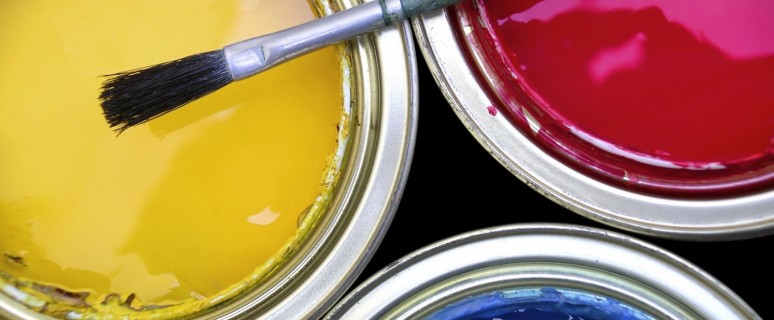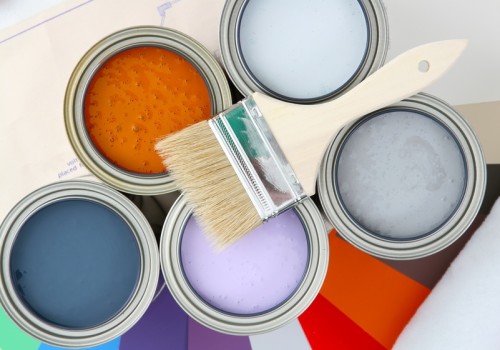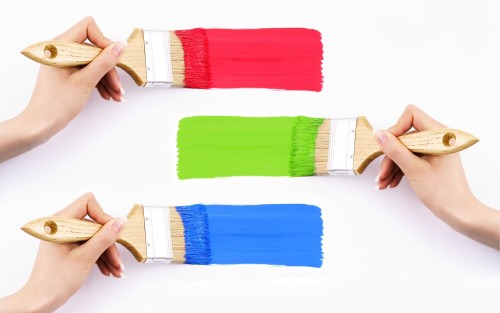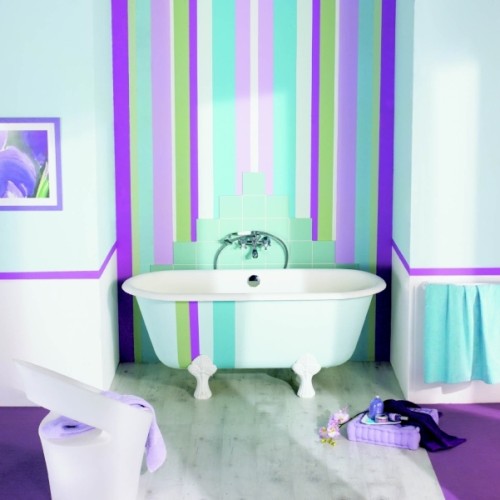
Water-dispersion paint: characteristics, advantages, features of application paints and varnishes

In the decoration of interiors and facades of buildings, water-dispersion paint is very often used as one of the highest quality and durable materials. We will tell about the features, types, specifications and advantages of such paint in this article.
Content
Features and Component Material Composition
Water-dispersion paint is a finishing paintwork, the main component in which synthetic polymers perform, often it is resin or oil. The paint solvent is water, which is why the material is considered environmentally friendly, harmless and fireproof. From the title of paint it is clear that it is a dispersion, that is, consists of solid microparticles located in a liquid component.
The feature of the wall finishing of water-dispersion paint is that a few hours after opening the surface, the water evaporates, and the solids form a dense impermeable layer, resistant to moisture and the effects of fire.
Such material is sold in the form of a thick suspension, which must be breeded with water to the desired consistency. Water-dispersion paint can have white color, and can be painted in a variety of shades. By the way, such a finishing material is available on sale just a unthinkable amount of colors.
In the component composition of paints there are substances:
- Film-forming materials are paint base. It is due to film consumers on the surface there is a polymer film that does not transmit water and resistant to abrasion. From how high-quality film consumers will be, the durability of the coating will be directly dependent.
- Dyes are components that give the paint a certain shade and are responsible for the decorativeness of the material.
- Fillers are another of the components of paint elements. Fillers are natural or synthetic origin and they are responsible for the operational and technical features of the paint. As such components, talc, copper, marble crumb, etc.
- Special additives give the water-dispersion paint additional properties, for example, are responsible for drying the composition on the surface, accelerate the process of dispersing dyes, etc.
Classification of water-dispersion paints
Water-dispersion paints are customary to classify by type of binder. Depending on what is the main component in the material, 3 groups of paints are distinguished:
- Water-dispersion polyvinila acetate paints are materials, the main substance in which polyvinyl acetate is. PVA paints have low hydrophobicity, which makes it impossible to use their use in rooms with high humidity, as well as in outdoor finishing works. Most often, such water-dispersion paints are used to design the ceilings in residential rooms or in work rooms where sufficiently dry air.
- Water-dispersive latex paints, which are also called butadiene-styrene dispersions are compositions based on rubbers. On the wall, they form a rather dense waterproof coating, resistant to moisture and mechanical effects. It is such a paint that is suitable for bathrooms, kitchens, cellars and other rooms where dampness and humidity are present. The latex coating is perfectly clean, does not affect detergents and disinfecting compositions, so the butadiene-styrene paint is relevant where the walls or gears must often be cleaned of contamination. This paint is applied to the surface very easily, because it spreads well. The treated wall after drying is obtained by smooth and glossy. The only significant lack of such a coating is its burnout under the action of light.
- Water-dispersive acrylic paints are considered universal material for finishing, because they are suitable for use not only inside, but also outside the premises. Acrylic compositions do not lose color saturation under the action of sunlight and retain decorativeness for a long time. They are waterproof, so they can be used in the facade finish. In the work, such materials are quite simple, applied to the surface easily and dried in a short time. Acrylic paint forms a vapor-permeable and elastic coating on the wall. Park permeability suggests that the surface under the paint will breathe, and the mold is not formed on the walls. And high elasticity indicates that after drying, the paint layer will not crack, and also calmly will withstand the temperature differences and mechanical effects. Another plus acrylic composition is the ability to fit well with the treated surface.
Specifications of water dispersion paints
The quality of paintwork material is largely determined by its technical characteristics. Consider them in more detail:
- The degree of white paint is responsible for its decorativeness. Initially, water-dispersive paint should be white, subsequently pigments are made into it, and it acquires the desired shade. And the whiter was the composition initially, the more beautiful, brighter and the juicy will be his color after staining. The degree of whiteness depends on the purity of titanium dioxide, which acts as a pigment.
- The shelterness of the paint is responsible for the ability of the material to cover the treated surface with the least amount of layers. The flow of water-dispersion paint depends on this indicator, and the shelterness is determined by the number and quality of pigments that are part of the substance, as well as dense and density of the material. 1 L water-dispersion paint should weigh about 1.5 kg - in this case the holling will be perfect. Manufacturers, wanting to reduce their products, can add too much water to the ground, then the paint density will be less than 1.5 kg / l. If an excessive amount of filler is present in the paint, the density will exceed 1.5 kg / l. In such cases, the coverage of the material will deteriorate.
- Water resistance is one of the working characteristics of water-dispersion paint. From this indicator directly depends on what conditions one or another composition can be used. For example, polyvinyl acetate materials have low water resistance, so they are only suitable for interior decoration, and the premises should not have high humidity. Paint the surface in the bathroom, in the kitchen or in the basement of paint based on polyvinyl acetate is not recommended.
- Light resistance determines the ability of paint to maintain its color under the action of sunlight or artificial lighting. It should be noted that polyvinyl acetate and acrylic materials in the sun are almost not fade away, but latex paints are prone to fading. The last coating option is preferably used in rooms where there is no constant intensive lighting, for example, in corridors or in the hallways.
- Resistance to mechanical impacts indicates how durable and durable coverage will be.
Depending on the conditions under which the material will be operated, the appropriate composition should be selected. From the above characteristics, it can be concluded that acrylic water-dispersion paint is most resistant to light and moisture, which makes it an optimal option for finishing facades or rooms with high humidity. But the latex paint burns out in the sun, but it is most resistant to abrasion, so such a material is suitable for finishing the hallway, corridor or basement.
Positive and negative properties of water-dispersion paints
The advantages of such a finishing material include such properties:
- Water-dispersion materials do not have in their composition organic solvents, and therefore they are considered environmentally friendly and harmless to health.
- Such paints also do not have a pronounced unpleasant odor, which makes it possible to use them without any problems as a material for the interior decoration of the rooms.
- Such formulations are very easily applied to the wall or other surface, so that even an unprepared person can work with them.
- Water-dispersive paints are not lit, so they are safe in the event of a fire.
- Acrylic paints are vapor permeable, so the wall covered with them has access to air. Due to this, the humidity in the premises will be optimal, and the condensate will not be assembled on the walls and mold to form.
- The paint is perfectly connected with the treated surface, without forming swirling. Such a coating is able to serve for many years, not peeling and not peeling. The service life of water-dispersion paint ranges from 10 to 15 years, provided that it is used with the implementation of all technological requirements.
- Such such a coating on the wall is very fast. Just only 1-2 hours, so that water evaporated from the paint and an impenetrable layer was formed on the surface.
- Water-dispersion formulations are mostly not subject to mechanical damage.
- The price of water-dispersion paint cannot be called very high, such a material is quite affordable to a person with a middle sufficiency.
- Waterproof paints, especially acrylic and latex, makes it possible to use them even in the most adverse conditions.
Among the shortcomings of water-dispersion paint it is worth highlighting the following:
- Working with such material depends largely on weather conditions. At low temperature and high humidity, the paint dries very slowly. If the surrounding air is colder than +5 ° C, then the formed coating during drying is covered with small cracks. And with high humidity, more than 80%, water from the material simply will not evaporate. It is impossible to finish the facades during the rain or snow, since raw paint is simply freezing in places from the surface. But even on a hot sunny day, too, it is also not necessary to engage in painting outdoor walls, since under the right sunny rays, the material will dry extremely quickly, not allowing it to apply it to a uniform layer.
- Water-dispersion paints require careful preliminary surface preparation, because under their thin layer, all irregularities and roughness become very noticeable.
- The price of such compositions may be higher than that of analogs produced on the basis of organic solvents.
Features of water dispersion paints
The technical characteristics of such finishing material make it possible to use it on various surfaces and in a variety of conditions. We will figure it out in this Read more:
- Acrylic water-dispersion paint design facades of buildings. Such material is perfectly connected with brick, concrete and plaster. Acrylic paint is resistant to moisture, temperature differences, effects of ultraviolet radiation. It does not fade in the sun and retains a beautiful look for a long time. In addition, such a coating passes air, but moreover is quite elastic and non-commercial. If it is necessary, the walls painted by such a composition can be easily laundering. Acrylic paint does not be engaged and not crackdown, and its alkaliiness is important when processing concrete walls.
- Water-dispersion paints on an acrylic basis found their use and as defensive compositions for building structures. They interfere with corrosion of concrete and reinforced concrete.
- In the interior of the premises, water-dispersive paints are not less common than in the design of facades. All paints are suitable for staining walls and ceilings in the rooms, but it should be remembered that only acrylic dispersions should be used in rooms with high humidity.
- Even the floor can be painted with dispersion compositions, but it is better to apply them only in those rooms where too high mechanical loads will not be affected.























